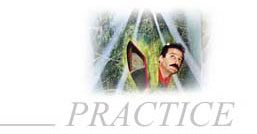Is a 'rectoversé' painting more a painting or a
sculpture? Or is it both at the same time? We have no hesitation:
we locate it in the two-dimensional field. The many tos and fros
between painting and sculpture and vice-versa which marked the
development of "rectoversion" correspond to this desire
to innovate without ceasing to paint as the academic avant-garde
from now proclaims. If "rectoversion" was born at the
very end of the XX° century, it is in the XXI° that it
will bloom.
The experiments that follow are examples of the various oscillations
between the two and three-dimensional modes which marked its genesis,
from 1978 to 1992.
The minimalist passage proved to be necessary but, since 1992,
the two painted sides maintain a relationship based on and not
on identity.
In addition, the role played by the third side asserts itself
with the passing of time, which definitively confirms the compound
nature of a "rectoversé" painting. This is why
it is much further away from the traditional double-sided work
than one would think. In any event, its field of experimentation
remains virgin.
The postulate of 'rectoversion' will have been to update the
back and then to propose a new composition while remaining strictly
two-bidimensional. It is true that the third side is its most
enigmatic side and certainly the most difficult not only to apprehend
but also quite simply to see. One does not perforate the visible
with impunity !


